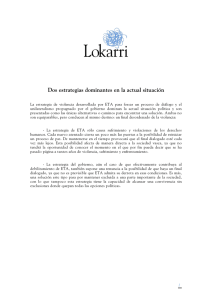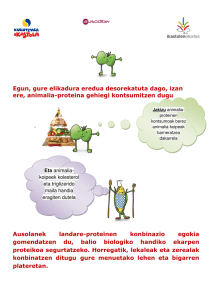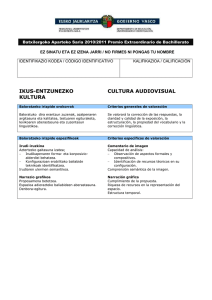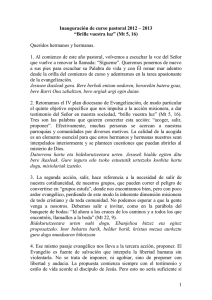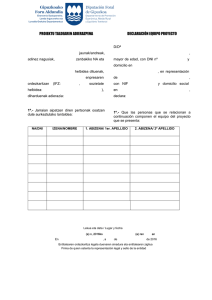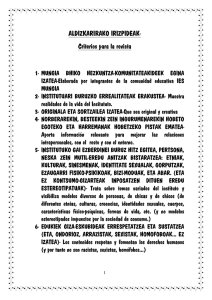Regina José galindo
Anuncio
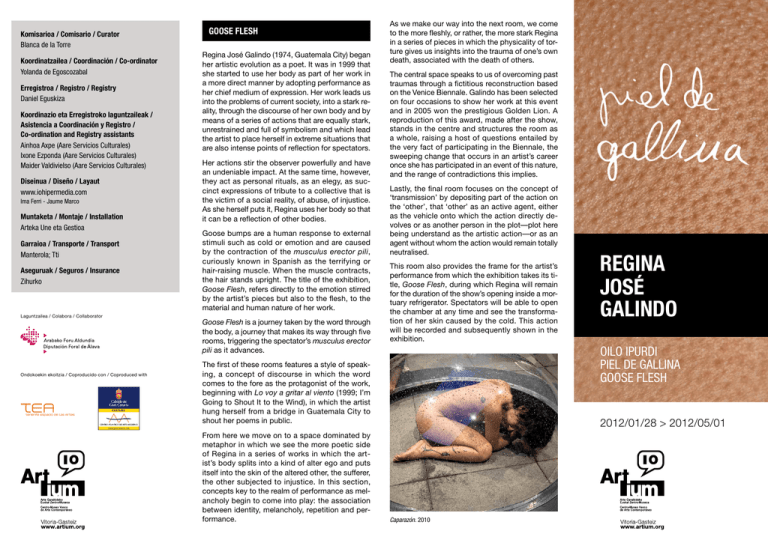
Komisarioa / Comisario / Curator Blanca de la Torre Koordinatzailea / Coordinación / Co-ordinator Yolanda de Egoscozabal Erregistroa / Registro / Registry Daniel Eguskiza Koordinazio eta Erregistroko laguntzaileak / Asistencia a Coordinación y Registro / Co-ordination and Registry assistants Ainhoa Axpe (Aare Servicios Culturales) Ixone Ezponda (Aare Servicios Culturales) Maider Valdivielso (Aare Servicios Culturales) Diseinua / Diseño / Layaut www.iohipermedia.com Ima Ferri - Jaume Marco Muntaketa / Montaje / Installation Arteka Une eta Gestioa Garraioa / Transporte / Transport Manterola; Tti Aseguruak / Seguros / Insurance Zihurko Laguntzailea / Colabora / Collaborator Ondokoekin ekoitzia / Coproducido con / Coproduced with GOOSE FLESH Regina José Galindo (1974, Guatemala City) began her artistic evolution as a poet. It was in 1999 that she started to use her body as part of her work in a more direct manner by adopting performance as her chief medium of expression. Her work leads us into the problems of current society, into a stark reality, through the discourse of her own body and by means of a series of actions that are equally stark, unrestrained and full of symbolism and which lead the artist to place herself in extreme situations that are also intense points of reflection for spectators. Her actions stir the observer powerfully and have an undeniable impact. At the same time, however, they act as personal rituals, as an elegy, as succinct expressions of tribute to a collective that is the victim of a social reality, of abuse, of injustice. As she herself puts it, Regina uses her body so that it can be a reflection of other bodies. Goose bumps are a human response to external stimuli such as cold or emotion and are caused by the contraction of the musculus erector pili, curiously known in Spanish as the terrifying or hair-raising muscle. When the muscle contracts, the hair stands upright. The title of the exhibition, Goose Flesh, refers directly to the emotion stirred by the artist’s pieces but also to the flesh, to the material and human nature of her work. Goose Flesh is a journey taken by the word through the body, a journey that makes its way through five rooms, triggering the spectator’s musculus erector pili as it advances. As we make our way into the next room, we come to the more fleshly, or rather, the more stark Regina in a series of pieces in which the physicality of torture gives us insights into the trauma of one’s own death, associated with the death of others. The central space speaks to us of overcoming past traumas through a fictitious reconstruction based on the Venice Biennale. Galindo has been selected on four occasions to show her work at this event and in 2005 won the prestigious Golden Lion. A reproduction of this award, made after the show, stands in the centre and structures the room as a whole, raising a host of questions entailed by the very fact of participating in the Biennale, the sweeping change that occurs in an artist’s career once she has participated in an event of this nature, and the range of contradictions this implies. Lastly, the final room focuses on the concept of ‘transmission’ by depositing part of the action on the ‘other’, that ‘other’ as an active agent, either as the vehicle onto which the action directly devolves or as another person in the plot—plot here being understand as the artistic action—or as an agent without whom the action would remain totally neutralised. This room also provides the frame for the artist’s performance from which the exhibition takes its title, Goose Flesh, during which Regina will remain for the duration of the show’s opening inside a mortuary refrigerator. Spectators will be able to open the chamber at any time and see the transformation of her skin caused by the cold. This action will be recorded and subsequently shown in the exhibition. Oilo Ipurdi Piel de Gallina Goose Flesh The first of these rooms features a style of speaking, a concept of discourse in which the word comes to the fore as the protagonist of the work, beginning with Lo voy a gritar al viento (1999; I’m Going to Shout It to the Wind), in which the artist hung herself from a bridge in Guatemala City to shout her poems in public. From here we move on to a space dominated by metaphor in which we see the more poetic side of Regina in a series of works in which the artist’s body splits into a kind of alter ego and puts itself into the skin of the altered other, the sufferer, the other subjected to injustice. In this section, concepts key to the realm of performance as melancholy begin to come into play: the association between identity, melancholy, repetition and performance. Regina José Galindo 2012/01/28 > 2012/05/01 Caparazón. 2010 Lehendabiziko esparrua mintzaerari dagokio, hitza lanaren protagonista bihurtzen duen gogoetabide bati. Abiapuntua 1999ko Lo voy a gritar al viento ekintza da, zeinetarako artista Guatemala Hiriko zubi batetik zintzilikatu baitzen bere poemak jendeari oihukatzeko. Hurrengoa metafora nagusi den esparru bat da, Reginaren alde poetikoena agerian uzten duena. Hemen, artistaren gorputza bitan banatzen da lan sorta batean, bestearen azalean, sufritzen duenaren, bidegabekeriaren mende dagoenaren azalean sartzen den halako alter ego bat eratuz. Atal honetan performancearen esparruan garrantzitsuak diren kontzeptuak agertzen dira, esate baterako, malenkonia: nortasunaren, malenkoniaren, errepikatzearen eta performancearen arteko lotura. Lo voy a gritar al viento. 1999 OILO IPURDIA Regina José Galindo (1974, Guatemala Hiria) poeta gisa abiatu zen artearen munduan, eta 1999 urtea arte ez zen bere gorputzarekin lanean hasi, modu zuzenago batean, adierazpide nagusi gisa performancea hautatuz. Bere lanek egungo gizartearen arazoetan sarrarazten gaituzte, errealitate gordin batean, bere gorputzaren kontakizunaren bidez, era berean gordinak, muturrekoak eta sinbolismoz beteak eta ikusleei gogoeta eginarazteko abiapuntu diren ekintza sorta baten bidez. Bere ekintzak eragin asaldatzaile bortitza dute ikusleengan, eta inpaktua ukaezina da. Baina aldi berean erritu pertsonalak, elegiak, gizarte errealitate jakin baten, gehiegikeria baten, bidegabekeria baten biktima den gizatalde bati egindako omenaldiak ere badira. Bere hitzetan, Reginak beste gorputz batzuen islada izateko darabil bere gorputza. Oilo ipurdia kanpoko eragingarrien –esate baterako hotza– edota barrukoen –esate baterako emozioa– ondorioz sortzen den adierazpen bat da, hau da, musculus erector pili delakoa, «gihar ile lazgarria» ere esaten zaiona, uzkurtu eta ilea laztu egiten du. Izenburu honek artistaren lanek eragindako emozioaren literaltasunera garamatza, baina baita azalera ere, haren lanak duen materiazkotasunera eta gizatiartasunera. Oilo ipurdia gorputzean barrena egindako bidaia da, bost aretotan zehar giltzatzen den bidaia, ikuslearen musculus erector pili delakoa esnatuz. Hurrengo esparruan Regina haragikoiena edota, hobeto esanda, gordinena aurkituko dugu. Bertako lanek islatzen duten torturaren fisikotasunaren bidez norbere heriotzaren trauma etorriko zaigu gogora, besteen heriotzarekin loturik. Erdiko espazioaren gaia trauma historiko batzuk gainditzea da, Veneziako Biurtekoaren inguruko alegiazko berregite batetik abiaturik. Galindo lau aldiz hautatu dute bere lana han erakusteko, eta Urrezko Lehoi ospetsua jaso du bere lanagatik. Lehoi horren erreprodukzio batek, geroago egina, egituratzen du aretoa, erdian kokaturik. Gune honetan Biurteko horretan parte hartzeak dakartzan kontuak eta gaiak planteatzen dira, esate baterako, artista batek horrelako gertakizunetan parte hartzeak bere ibilbidean eragiten duen aldaketa sakona, edota horrek ondorioz dakartzan kontraesanak. Azkenik, azkeneko esparrua «transmisio» kontzeptuaren inguruan giltzaturik dago, ekintzaren parte bat «bestea»-rengan kokatzean, «beste» hori eragile aktibo gisa, nahiz ekintza zuzenean jasotzen duen hartzaile gisa, nahiz gertakizunaren pertsonaietariko baten gisa –gertakizuna ekintza artistiko gisa ulertuz–, edota eragile gisa, zeina gabe ekintza hori bizirik gabe geratuko litzatekeen. Hemen kokatzen da erakusketari izena ematen dion Oilo ipurdia performancea ere. Inaugurazioak dirauen artean artista hil-hozkailu baten barruan egongo da, eta ikusleek noiznahi zabaldu ahal izango dute atea, hotzaren eraginez haren azalaren itxura nola aldatzen den ikusteko. Ekintza hau filmatu egingo da eta argitaratu ondoren erakusketa osatuko duen beste pieza bat izango da. PIEL DE GALLINA Regina José Galindo (1974, Ciudad de Guatemala), comienza su desarrollo artístico como poeta, y será en 1999 cuando comience a trabajar con su cuerpo de un modo más directo, al adoptar la forma de la performance como principal medio de expresión. Su obra nos introduce en problemáticas de la sociedad actual, en una realidad descarnada, a través del discurso de su propio cuerpo, por medio de una serie de acciones igual de descarnadas, extremas y cargadas de simbolismo, que llevan a la artista a colocarse en situaciones límite y que implican puntos de reflexión intensos para los espectadores. Sus acciones actúan como potentes agitadores del observador, y el impacto es innegable. Pero al mismo tiempo actúan como rituales personales, como una elegía, como pequeños homenajes hacia una colectividad víctima de una realidad social, de un abuso, de una injusticia. En sus propias palabras, Regina utiliza el cuerpo para ser reflejo de otros cuerpos. La piel de gallina es una manifestación humana producida por estímulos externos como el frío o internos como la emoción, por la cual el musculus erector pili, curiosamente también llamado «músculo horripilante», se contrae y se eriza el pelo. Este título nos remite a la literalidad de la emoción suscitada por las obras de la artista, pero también a la propia piel, a lo matérico y a lo humano de su trabajo. Piel de gallina es un viaje de la palabra a través del cuerpo, un viaje que se articula a través de cinco salas, despertando el musculus erector pili en el espectador. Al pasar a la siguiente sala nos adentramos en la Regina más carnal, o más bien más descarnada. Una serie de piezas donde la fisicidad de la tortura nos acerca al trauma de la muerte de uno mismo, asociado con la muerte de los otros. El espacio central nos habla de la superación de algunos traumas históricos a partir de una reconstrucción ficticia en torno a la Bienal de Venecia. Galindo ha sido seleccionada para mostrar su obra en esta muestra en cuatro ocasiones, y su trabajo le llevó a ganar el prestigioso León de Oro. Una reproducción de este, realizado con posterioridad, articula la sala desde su posición central, a fin de plantear toda la serie de cuestionamientos que el hecho de participar en esta Bienal en concreto conlleva, el cambio radical que la participación de un artista en este tipo de eventos representa para su trayectoria, así como la serie de contradicciones que esto implica. Finalmente, el último ámbito se centra en el concepto de «transmisión», en depositar parte de la acción en «el otro», ese «otro» como agente activo, bien como el vehículo sobre el que recae directamente la acción, como un personaje más de la trama –entendiendo trama como acción artística–, o como agente sin el cual dicha acción permanecería totalmente desactivada. Aquí se encuadra también la performance que la artista realiza bajo el título homónimo Piel de gallina, en el que permanecerá durante toda la inauguración en el interior de un refrigerador mortuorio, y los espectadores podrán abrir la cámara en cualquier momento y contemplar el proceso de transformación de su piel provocado por el frío. Esta acción será grabada y posteriormente mostrada en la exposición. El primero de los ámbitos responde a la elocución, a un concepto de discurso en el que la palabra se erige en protagonista de la obra, comenzando por Lo voy a gritar al viento, de 1999, donde la artista se colgó de un puente de la ciudad de Guatemala para gritar públicamente sus poemas. De aquí pasaremos a un espacio dominado por la metáfora, donde se nos muestra la Regina más poética, a través de una serie de obras en las que el cuerpo de la artista se desdobla en una suerte de álter ego para ponerse en la piel del otro alterado, del sufriente, del otro sometido a la injusticia. En este apartado ya comienzan a entrar en juego conceptos clave en el ámbito de la performance como la melancolía: la asociación entre identidad, melancolía, repetición y performance. ¿Quién puede borrar las huellas? 2003
![BENITO LERTXUNDI 2016 AURKEZPENA [EUSK] Benito Lertxundi oriotar kantaria 50 urteko ibilbidea](http://s2.studylib.es/store/data/003275657_1-775a20bd8379331132eed08361016209-300x300.png)
